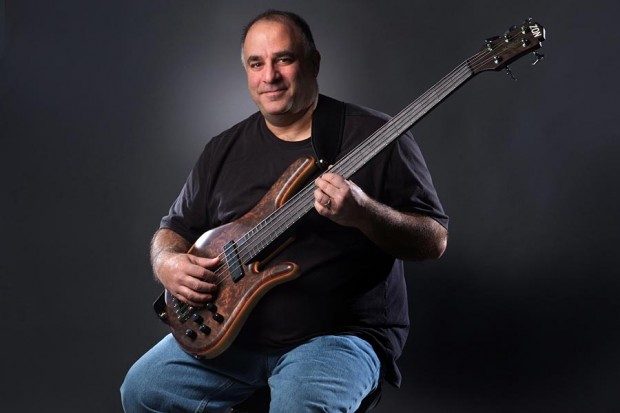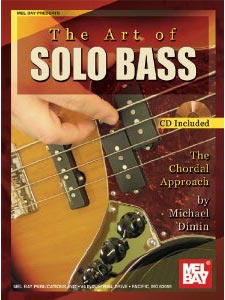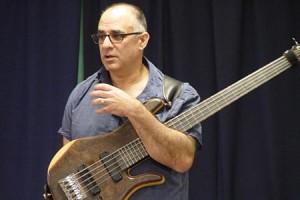New School: Mike Dimin

Mike Dimin is a bassist that focuses on stretching what he calls “The Chordal Approach.” Inspired in part by jazz guitarist Joe Pass, Dimin took his knowledge of melody, harmony, and rhythm to start making chord-melody arrangements of songs for bass. He also utilizes a looper to create “lush arrangements of everything from Jazz Standards to R&B and pop classics to [his] original ethereal, melodic jazz.”
What makes you new school?
It is a little bit funny to think of what I do as “new school.” I’ve been playing and arranging for solo bass since 1979 when I was a student at Berklee. That being said, I do believe that I have, in a small way, expanded the vocabulary of bassists. I’ve accomplished this by introducing chords, chord-melody arrangements and loops; by envisioning a solo bassist on stage; by focusing on melody and the delicate and wondrous relationship between harmony and melody, and working the entire bass to find the nuance and beauty of the instrument. Yet, what I hope is the most “new school” of any of the work has been the ability to bring those years of work and imagination to others. Whether it has been through lessons, workshops or master classes; whether it was from the many lessons columns I’ve written for magazines and websites or the arrangements that I have provided for students auditioning for colleges, it has been the sharing of knowledge and, hopefully, the inspiration, that I have provided, that makes me truly “new school”.?
How did you discover new school style?
I grew up at a very cool time to be a bassist, with Stanley and Jaco leading the way. With the advances in recording technology and the new role of the bassist, we found ourselves in a bit of a revolution. Jeff Berlin, Jon Camp (Renaissance), Percy Jones and many more were bringing the bass to the forefront of the music. It opened many doors for me and allowed me see the possibilities of the instrument.
I went to college as a Biology major with music as more or less a hobby. Although my parents were very supportive, the thought of actually making a living as a musician seemed rather remote. I had a music professor that changed all those perceptions. I transferred to Berklee. Although I didn’t actually graduate from Berklee (who does?), this was the most influential time in my development. It was 1979, Jaco was THE MAN and Berklee was THE PLACE. It was there that I realized the bass was an instrument that could far surpass the accepted expectations/limitations imposed on us by both other musicians as well as those that we impose upon one’s self.
I had heard a rumor of a Buffalo, NY bassist that could play chord/melody arrangement of the jazz standard, “Misty”. I started working out my own arrangement and the rest, as they say, is history. ?I soon realized that this was a wonderful way to develop a better understanding of the relationship between harmony, melody and rhythm. I started to incorporate all of the aspects of jazz standards in a chord-melody style. I termed these techniques, “The Chordal Approach.” ?
After transferring back to the University and getting my degree in Composition, I moved to the mountains of Vermont and had little or no desire to gig. I was working out solo bass arrangements, trying to put my theories to test. That was until my mom called, “you know that bass player you like so much … he was killed.” I just could not believe it, I went to the library and, sitting on the dirt floor in the basement, went through the three months of obituaries in the New York Times. I had realized that not only had Jaco died, but many other wonderful artists, who had shared their gifts with the world, had passed as well. I felt a renewed energy to share my work. I started gigging again and, more importantly codifying my arrangements of jazz standards into written form and explain the technique for the initial version of my book, The Chordal Approach. The first version was entitled, Standards for Solo Bass. Although Standards for Solo Bass had some major publishing interest (I still have the letter that states, “we will contact you in about three weeks to finalize a deal”), Standards for Solo Bass never got picked up by the major publishing company.
 Not having the resources to attain license for all the arrangements, I decided to rewrite the book, taking out the works of others and marketing it myself. It was also about this time that I contacted Dale Titus, then editor of Bass Frontiers Magazine to see if he would be interested in publishing some of my techniques. Dale was very interested but ended up leaving the position shortly after. Publisher and Editor Jim Hyatt picked up the ball and ran with it. From May of 1998 until its unfortunate demise, I wrote a regular lesson column for Bass Frontiers Magazine. Since then I have written for Bass Player, Bassics, Bass Guitar Magazine and was one of the original “Ask The Pros” on Talkbass. It was with Mel Bay that I was able to reinstate some of the arrangements and reinvented the book, The Art of Solo Bass.
Not having the resources to attain license for all the arrangements, I decided to rewrite the book, taking out the works of others and marketing it myself. It was also about this time that I contacted Dale Titus, then editor of Bass Frontiers Magazine to see if he would be interested in publishing some of my techniques. Dale was very interested but ended up leaving the position shortly after. Publisher and Editor Jim Hyatt picked up the ball and ran with it. From May of 1998 until its unfortunate demise, I wrote a regular lesson column for Bass Frontiers Magazine. Since then I have written for Bass Player, Bassics, Bass Guitar Magazine and was one of the original “Ask The Pros” on Talkbass. It was with Mel Bay that I was able to reinstate some of the arrangements and reinvented the book, The Art of Solo Bass.
Share some of your videos with us
Although I don’t show my “thing” in public, I do have some videos of my new school techniques. This is a performance I did for the regional TED Conference of “There Are No Accidents”, the title song of my second CD. ?
Here is a Youtube Playlist, it has some solo pieces as well as some wonderful Bass and Cajon duets. ?
??
Finally, here is a video of Kylie and the Sympathetic Strangers. I really love this video, primarily because my son, a film maker, created it.?
There are also some companion videos to my lesson articles from Bass Guitar Magazine (UK) floating around YouTube.
What kind of gear do you use?
As a solo bassist, it’s been a continual search to find the right gear. Many companies build gear that appeal to the largest market. The typical bass sound, that we all love so much, is not ideal for solo bass. When playing chords, chord melodies or four or five simultaneous loops on bass, a certain clarity and balance across the strings and the frequency range is vital. For years I searched for an instrument that can be set up with tolerances to the 1,000th of an inch and provide enough tonal variation for solo bass gigs as well as my “old school” gigs. I looked for strings that are both easy to play and don’t have too much harmonic overtone content as to remain crystal clear. Finally I needed an amp rig that was studio quality that could produce all the tones with a clarity and definition only available in a full range amp and cab.
Being in the “industry” and having a chance to meet many builders, manufacturers, sales reps and players has afforded me the ability to try many things and find the tools that work best for what I do. The graphite neck of my 5-string Zon basses (34? scale) have a stability that is just amazing; whether I need to use alternative tunings or just the normal weather changes here in the great Northeast, I can count on the Zon to keep it’s relief of 4/1000ths of an inch. The graphite neck also provides so much clarity. The only bass I have played that comes close to the clarity of the Graphite neck is an ash neck on a MTD 535, I once owned. ?
For strings I use Thomastick-Infeld Jazz Rounds (E to C). TI are known more for the flats than their rounds and these strings are not for everyone. They are VERY soft to the touch and the super fine outer winding makes them feel like a ground wound. They have a silk wrap between the inner core and outer wrap that provides a very strong fundamental and diminishes, somewhat, the harmonic overtones.
Through my long standing relationship with EA (Euphonic Audio), I have been afforded the opportunity to give input on those things that I need in an amp. From my idea of the Intelligent Input Switching, of the Micro amps, to input on prototypes, my relationship with EA has been beneficial in providing me amps that fit my needs to a tee.
Finally, I had envisioned a looper pedal as early as 1980 (when only the Echoplex was available). I have been a loyal “rangster” (Boomerang user) since 1999. Their latest version, The Boomerang III, finally provides me with the fidelity to use it both live and in the studio. Boomerang has been a company that has actively sought out the input of it’s users. ?
As you can tell, I like working with smaller companies. Companies that listen and value the input of their users.?
What kind of gigs do you get with your new school style?
There are two basic kind of gigs I get as a solo bassist. The first is what I call wallpaper gigs – providing background music at restaurants, events, house parties, etc. Although this sounds kind of pedestrian, there are some really valuable aspects of this kind of gig. Because there is little pressure on a gig like this, it really allows me the opportunity to grow; to try new things; to really push the envelope (while still getting paid). Because the audience is not listening too critically, there is so much freedom. Many times they do not even realize that I am playing bass!
 The second genre of gigs are the solo bass performance/workshops. These are performed, until recently, primarily for bass players at dedicated bass events. Some of the events include gigs at the Detroit Bass Fest, Bass Quake, The Anaheim Bass Bash, Gerald Veasley’s Bass Bootcamp, Canadian Rockies Bass Bash, as well as many of the regional Bass Get Together events. These gigs are usually some combination of performance and teaching. Recently, I have expanded these workshops to audiences of non musicians.?
The second genre of gigs are the solo bass performance/workshops. These are performed, until recently, primarily for bass players at dedicated bass events. Some of the events include gigs at the Detroit Bass Fest, Bass Quake, The Anaheim Bass Bash, Gerald Veasley’s Bass Bootcamp, Canadian Rockies Bass Bash, as well as many of the regional Bass Get Together events. These gigs are usually some combination of performance and teaching. Recently, I have expanded these workshops to audiences of non musicians.?
Any traditional playing gigs?
Yes! I end that with an exclamation because I want to make it clear that I am much more than a solo bassist. One hates to be “typecast”, especially if it means that people don’t call you for work. One of the drawbacks of playing solo is that you miss the camaraderie of other musicians, you miss the give and take, you miss hearing and exposing yourself to the ideas of other musicians (plus there is no one to hang with at set breaks). In addition to solo gigs and duo gigs with the Cajon player, I play with a number of regional groups. I play with an Americana/Roots band, Kylie and the Sympathetic Strangers; a Jazz Trio, A3 and a bawdy Irish band, Emerald Dawn. Additionally, I am always available for freelance gigs.?
Do you have albums where we can hear your new school style?
I have two recordings, Big Droppins’ and There Are No Accidents, both are available on CD or by download at CDBaby.com (and, of course, through my website). Neither recording is just solo bass. There is so much music and so many people that I wanted to work with that I, hopefully, reached a balance.
For example, on my first record, Big Droppins’ I had the wonderful opportunity to record with Grammy winner, Paul McCandless (Paul Winter, Oregon, Bela Fleck). I have been a huge fan of his, for many years, and wrote two pieces specifically with him in mind. I have been offering to anyone who buys my book, The Art of Solo Bass (Mel Bay), directly from me, a free download of my second album, There Are No Accidents.?You can also find my music on many download or streaming sites like iTunes or Spotify.?
Where can we find you on the web?
My web site is michaeldimin.com. I also play with an Americana/Roots band which can be found at sympatheticstrangers.com. Also, I hope people will “like” my solo bass Facebook page. Finally, I have a much underutilized Twitter account that I need to get busy on, please follow me at @solobassmike.?
What’s next for you?
As I mentioned earlier, I am expanding my solo bass performance/workshops to a non musical audience; focusing on corporate clients, community groups, schools, etc. I have created a new workshop entitled “Whose Box is This Anyway, A Path to Innovation and Critical Thinking”.
“Whose Box Is This Anyway” is a humorous, inspirational and insightful look into the path to creativity, innovation and critical thinking. Through performance and commentary, I show that there is so much more than “thinking outside the box.” Here is a bit from the intro to the book I am writing about it: “How many times have we heard “Think Outside the Box?” The intention of that statement is to make us a more creative and critical thinker. However, few of us know what that box represents and, more importantly, who defines that box for us. The walls of that box are our limitations and expectations. Some self imposed and many imposed upon us by others. These limitations and expectations strangle and stifle the creativity each of us posses. They work, diligently, to limit our possibilities and potential. They ensure mediocrity.?We cannot “think outside the box.” We can, however push back the walls of that box, allow ourselves all the inspiration, creativity, critical thought and innovation that has been eluding us. We must strive to recognize who built that box; who defined those expectations and limitations. Only then can we begin our journey to critical thinking and innovation.”?
What else do you want to share?
A few things. One of the great things about bass players is that we seem to have a better sense of community than other musicians, egos be damned! I host a local bass group and through our irregular meeting, I have been able to meet and present some really inspirational players. It is amazing to see all the talent that lives in your community and the commitment other players will make to speak to and teach the group.
Secondly, if you’re ever in the upstate NY/Capital Region, please feel free to reach out. It would be a pleasure to meet you or come see you play. If it has not been too obvious from the above, performing, for me, is a means to share, to teach, to educate, to inspire. If you are in the area or want to learn some of my ideas, feel free to contact me about lessons (in person or Skype). Finally, if your group, community organization or business is interested in “Whose Box Is This Anyway”, please feel free to reach out. Thanks!

